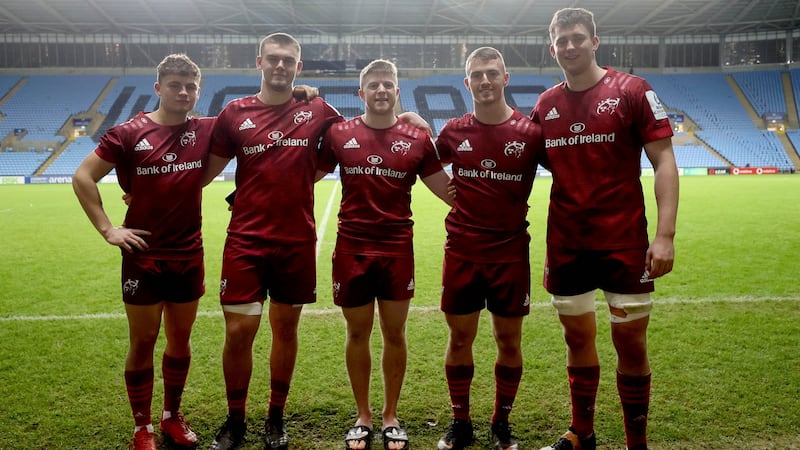Last week the United Rugby Championship (URC) chief executive Martin Anayi revealed that it had been asked to look into the viability of an "A" team league or a "next generation" competition. It might have an under-23 developmental aspect to it and would be held over four to six weekends during international windows.
Go away, next gen cup. Go very far away.
Much like the British & Irish Cup, the Celtic Cup and most certainly that one-off Cara Cup in the USA, it sounds like money down the drain on a competition that, save for the squads themselves and the provincial coaches, would pretty much mean nothing to anybody.
It’s an ill wind and all that, but the absence of a B&I Cup, or Celtic Cup, or Cara Cup or next gen cup has been a boon for the All-Ireland League. Not before time players within the provincial set-ups, be they fully contracted or more often academy players, were released more often to the clubs on Energia All-Ireland League weekends.
The net effect was to raise the standards like never before, according to many who’ve been involved in the AIL over a long period of time, especially in Division 1A, but beyond the top flight too.
One understands why the provincial hierarchies want “A” games and even more so why players are compelled to play in them. They expose the players to a more professional environment, introduce them to the provinces’ playing styles and are instructive for the coaches.
However, whereas interpros would maintain some “A” games, aside from the additional cost of a B&I/Celtic/Cara/next gen cup, they also suck the blood out of the AIL.
Widening the disconnect
They also reinforce the theory that players cannot be prepared for the professional game at club level while further widening the disconnect between the provinces and their own clubs.
At times you’d like to remind the four proud provinces of Ireland that in actual fact they did not invent the game and that they have a duty toward their clubs, which at times they seem to forget.
At times, too, you wonder if the provinces just pay lip service to the idea that the clubs are “important” to them, all the more so if they have been partly behind the request to explore a next gen competition.
To Munster’s credit, their weekly squad update details every player in their squad, senior or full-time, who played for their clubs in the AIL the previous weekend. By rights, every province should do this.
No one felt the full benefit of their players playing in the AIL more than Munster last December when a makeshift team of rested frontliners and academy players went to Coventry and beat Wasps. The latter would not have been able to step up to the plate had it not been for their game time in the AIL.

Not much was expected of the Irish under-20 team this season but as it turned out they won another Grand Slam and assuredly would not have done so but for their players’ exposure to the AIL.
The makeshift Leinster squad which contrived to earn the two losing bonus points away to the Sharks and Stormers to secure top place in the URC would not have done so but for the game time many accrued in the AIL.
Clontarf provided five players over the two games and, fittingly, the day after Alex Soroka was man of the match in his first start for Leinster, his brother Ivan made the telling contribution at an attacking Terenure scrum when reintroduced late on.
Improvement
For example, Cormac Foley made his first Leinster start against the Stormers after a Division 1A campaign in which his improvement made him arguably the scrumhalf of the AIL this season.
Such was his commitment to the Lansdowne cause that on Friday February 25th, after being an unused 24th man in Leinster’s win over the Lions at the RDS, he hurried to the Aviva back pitch to play in his club’s game against Clontarf.
Furthermore, despite the lingering impact of the pandemic, of the 475 AIL games in total, only eight were called off.
Last Sunday’s final especially and the promotion and relegation ties over the previous two Saturdays provided vindication for the playoffs.
Admittedly, this season’s one-off format, in which the top four in each of the five divisions went into semi-finals, and the bottom two into relegation playoffs in each of the five divisions, was not without its flaws.
The 5,799 crowd also generated more atmosphere than was the case at any of Ireland's three home games in the <a href="http://cms-live-p-service:8080/preview/www/2.789/2.4171/7.1213540?article=true&tag_event=Six+Nations" polopoly:contentid="7.1213540">Six Nations</a> – but hey, let's not go there
Old Wesley will be feeling aggrieved at missing out on promotion to Division 1A after finishing 10 points clear in 1B and 11 ahead of third-placed Shannon, who eventually won promotion. Resting their first-choice team for their final regular season match two weeks before the playoffs away to Shannon and losing 61-12 perhaps wasn’t too clever in hindsight.
Queen’s will be equally sore after dominating Division 2A, finishing a whopping 14 points clear in first place.
A fairer system, while keeping the jeopardy element in the playoffs, would be to reward first place from Division 1B down with automatic promotion, and automatic relegation for finishing last. Beyond that, the ninth-placed side in 1A would go into relegation/promotion semi-final playoffs with the sides finishing second, third and fourth in 1B, and so on down.
More atmosphere
Ultimately, Division 1A had both the final and perhaps the winners it deserved. The 5,799 crowd also generated more atmosphere than was the case at any of Ireland's three home games in the Six Nations – but hey, let's not go there. This was in large part to the way the Terenure club and community, including the school, sought to make their first final appearance a memorable one.
That added to the colour and the singing, an example being when Clontarf fullback Tadhg Bird, who'd sealed their semi-final with a sublime finish through the middle of the Cork Con defence, knocked on inside his 22 early on.
Mindful of Clontarf’s five defeats out of six in final appearances, the Terenure crowd sang the chorus from The Cranberries’ Zombie: “In your head, in your head . . .” Cruel, but clever.
Terenure may well come back even stronger next season after finishing second and reaching the final without one provincially contracted or academy player.
To Clontarf’s credit they sealed their third AIL with a 19th win in 20 matches, and while providing five players to Leinster’s two bonus-point defeats in South Africa. Clontarf did themselves, the AIL and their province proud.
Yeah, go away, next gen cup. Go very far away.















